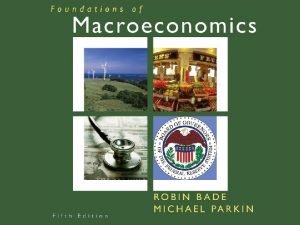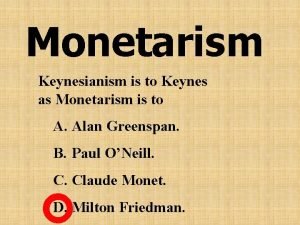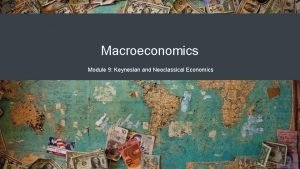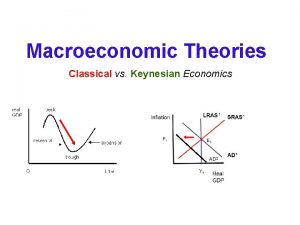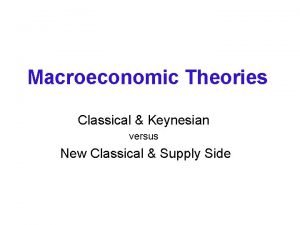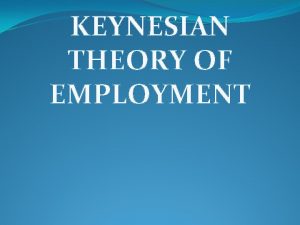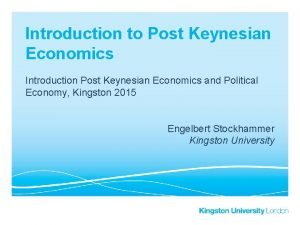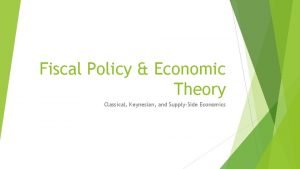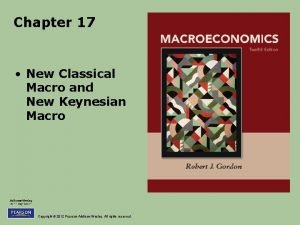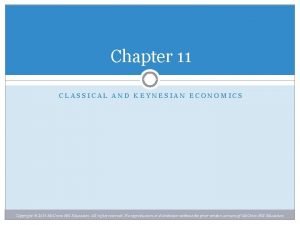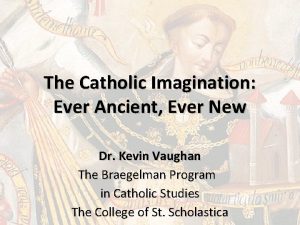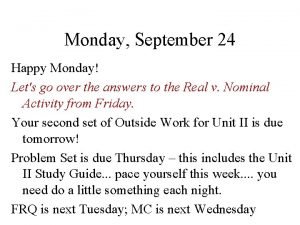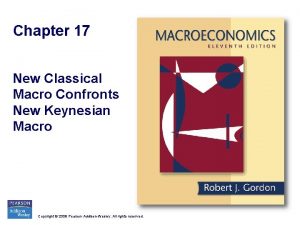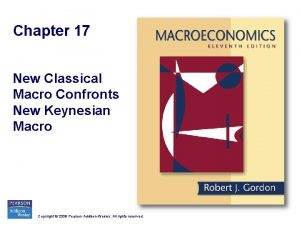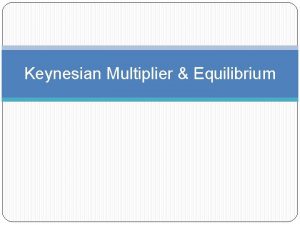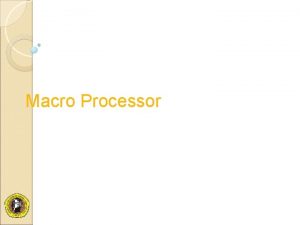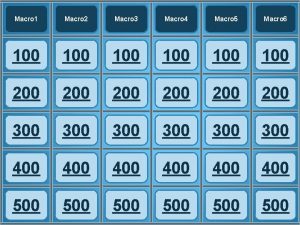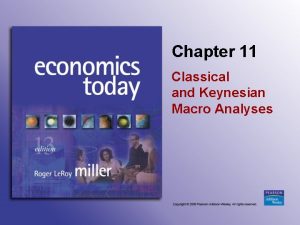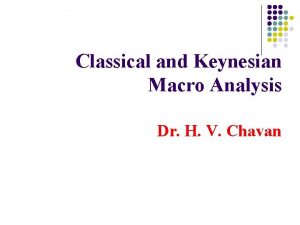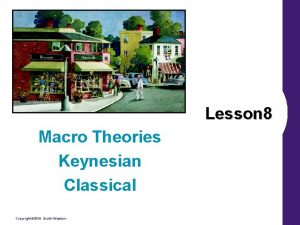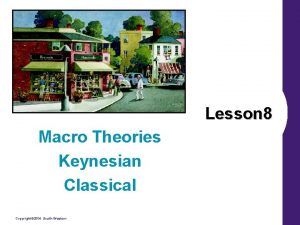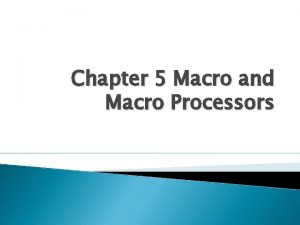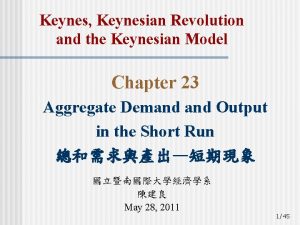Chapter 17 New Classical Macro Confronts New Keynesian


















- Slides: 18

Chapter 17 New Classical Macro Confronts New Keynesian Macro Copyright © 2009 Pearson Addison-Wesley. All rights reserved.

The Development of Macroeconomics • The development of new theories and the abandonment of old theories often occur in response to major macroeconomic development. – In the 1930 s, the Great Depression spurred the Keynesian revolution. – Keynesian thought dominated macroeconomics until significant inflation emerged in the late 1960 s and brought about the monetarist “counterrevolution. ” • Since the early 1970 s, macroeconomics has been split between two basic explanations of business cycles. – New Classical Macroeconomics – New Keynesian Economics Copyright © 2009 Pearson Addison-Wesley. All rights reserved. 2

The “Fooling Model” • In 1967, Milton Friedman developed a model of the economy where all markets clear continuously, but there is imperfect information. – Firms always know the current value of the price level, but workers only learn the actual price level with a time lag. • Suppose there is an increase in AD – Higher AD boosts prices encouraging firms to increase output. – Nominal wages also rise, but not as quickly as the price level. – Because workers do not realized that their real wage has fallen, they are willing to work more in response to AD. – When workers realize that their nominal wages did not keep up with the price level (i. e. that they were “fooled”), they demand higher wages shifting back AS. • Implication: Business cycles happen only because workers are fooled. Copyright © 2009 Pearson Addison-Wesley. All rights reserved. 3

Figure 17 -1 Effect of an Adverse Supply Shock on Output and Employment in the Real Business Cycle Model Copyright © 2009 Pearson Addison-Wesley. All rights reserved. 4

Other Versions of the Fooling Model • The Fooling Model obeys the Natural Rate Hypothesis, which states that shifts in AD have no long-run effect on real GDP. • Edmund Phelps developed a similar model to Friedman’s where both firms and workers were fooled by a general rise in the price level. • In another model, turnover unemployment is reduced (thus boosting output) when workers stay with their own firms when receiving wage increases not realizing that all wages have risen. Copyright © 2009 Pearson Addison-Wesley. All rights reserved. 5

The Lucas Model • The Lucas Model (named after Robert Lucas) has three basic assumptions: – – – • Suppose there is a “price surprise. ” – – – • Markets clear. There is imperfect information. There are Rational Expectations, which are expectations that need not be correct, but must make the best use of available information, avoiding errors that could have been foreseen by knowledge of history. Firms cannot distinguish between an increase in their own price vs. an increase in the general price level. Firms respond to a higher price by increasing output and employment (and thus, wages). If firms discover that the “price surprise” was a general increase in the price level, they reduce their output and wages back to their original levels. Implication: Anticipated monetary policy cannot change real GDP in a regular and predictable way. This is the Policy Ineffectiveness Proposition. Copyright © 2009 Pearson Addison-Wesley. All rights reserved. 6

Figure 17 -2 The Price-Setting Decision of a Monopolist Copyright © 2009 Pearson Addison-Wesley. All rights reserved. 7

The Real Business Cycle Model • The problem with the Fooling Model and the Lucas model is the easily available aggregate price information that makes it unlikely that imperfect information is the only source of business cycles. • The Real Business Cycle (RBC) model explains business cycles in output and employment as being caused by technology or supply shocks. Copyright © 2009 Pearson Addison-Wesley. All rights reserved. 8

Figure 17 -3 The Price-Setting Choice of a Monopolist Facing a Decline in Demand Copyright © 2009 Pearson Addison-Wesley. All rights reserved. 9

Criticisms of RBC models • Although technology may advance at an irregular pace, there is no retreat in technological progress to explain recessions. – Big recessions require big supply shocks. • RBC models imply that prices should fluctuate positively with output, but sometimes prices rise during recessions. • RBC models imply that real wages are procyclical; however, the statistical evidence suggests there is no systematic movement of real wages. Copyright © 2009 Pearson Addison-Wesley. All rights reserved. 10

International Perspective: Productivity Fluctuations in the United States and Japan (1 of 2) Copyright © 2009 Pearson Addison-Wesley. All rights reserved. 11

International Perspective: Productivity Fluctuations in the United States and Japan (2 of 2) Copyright © 2009 Pearson Addison-Wesley. All rights reserved. 12

Contributions of New Classical Macro • What are the attractions of new classical theory to economists? – The assumption of rational expectations requires that people do not repeat mistakes. • It also provides microeconomic foundations to macroeconomic theory. – Many of the ideas developed by new classical economists have been applied successfully to financial markets where continuous market clearing is a reasonable assumption. – Greater understanding of economic policy. – New techniques of analysis developed have had a pervasive effect on economic research. Copyright © 2009 Pearson Addison-Wesley. All rights reserved. 13

The New Keynesian Economics • New and old Keynesian models are Non-Market Clearing models, meaning that workers and firms are not continuously on their respective demand supply schedules. • The New Keynesian Economics explains rigidity in prices and wages as consistent with the self-interest of firms and works, all of whom are assumed to have rational expectations. • The difference between new and old Keynesian models is that the new approach attempts to explain the microeconomic foundations of slow adjustment of both wages and prices. Copyright © 2009 Pearson Addison-Wesley. All rights reserved. 14

Figure 17 -4 The Relationship Between the Relative Wage Rate and Worker Efficiency Copyright © 2009 Pearson Addison-Wesley. All rights reserved. 15

The Effect of Small Rigidities • A Menu Cost is any expense associated with changing prices, including the cost of printing new menus or distributing new catalogs. • A Macroeconomic Externality is a cost incurred by society as a result of a decision by an individual worker or firm. • A Coordination Failure occurs when there is no private incentive for firms to act together to avoid actions that impose social costs on society. Copyright © 2009 Pearson Addison-Wesley. All rights reserved. 16

The Efficiency Wage Model • The efficiency wage model explains real rigidities by arguing that firms do not want to cut wages relative to the wage paid by other firms. – A higher relative wage encourages greater effort by workers. • Suppose demand falls. – Firms respond by cutting employment while maintaining the “efficiency wage. ” Copyright © 2009 Pearson Addison-Wesley. All rights reserved. 17

Criticisms of the New Keynesian Approach • The new Keynesian approach solves the main dilemma of earlier business cycle models studied. That is, it explains observed business cycles without: – – Assuming away output fluctuations. Assuming complete wage rigidity. Requiring imperfect information. Assuming procyclical wages. • Criticisms of the new Keynesian approach: – It provide too many reasons why wages and prices are sticky. – Empirical testing of this approach is still in its infancy. Copyright © 2009 Pearson Addison-Wesley. All rights reserved. 18
 New classical macroeconomics
New classical macroeconomics New classical and new keynesian macroeconomics
New classical and new keynesian macroeconomics Classical keynesian and monetarist
Classical keynesian and monetarist Keynesianism
Keynesianism Classical versus keynesian economics
Classical versus keynesian economics Classical economics vs keynesian
Classical economics vs keynesian Keynesian vs classical vs monetarist
Keynesian vs classical vs monetarist Keynesian and classical theory
Keynesian and classical theory Classical economics vs keynesian
Classical economics vs keynesian Classical economics vs keynesian
Classical economics vs keynesian Keynesian vs classical vs monetarist
Keynesian vs classical vs monetarist Keynes law
Keynes law America confronts the post-cold war era
America confronts the post-cold war era Nathan confronts david
Nathan confronts david Aeneid book 4 summary
Aeneid book 4 summary Apollo with battling lapiths and centaurs
Apollo with battling lapiths and centaurs Happy monday answer key
Happy monday answer key Macro processor algorithm and data structures
Macro processor algorithm and data structures Keynesian cross
Keynesian cross


